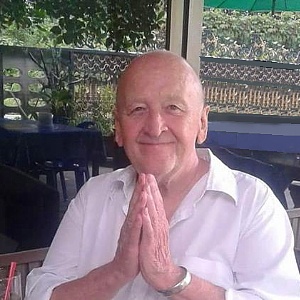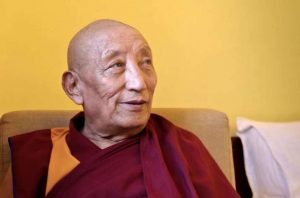There are two ways to approach awakening: one is to try to struggle on alone on your own. The other is to find a good teacher who has already done the work and is happy to share what they know by generously providing useful pointers and guidelines.
One such teacher was Ajahn Lee Dhammadharo (1907–61), an influential teacher of the Thai forest tradition in the last century. Imagine you are sitting at his feet, there in a quiet, secluded forest setting, listening carefully and turning his directions into actions.
Below, I’ll a paraphrase and explicate, following one of Ajahn Lee Dhammadharo’s talks. Let’s proceed step-by-step:
First, begin by taking three to seven long in-and-out breaths, repeating the mantra, “Bud/dho,” thinking “bud,” with each in breath and “dho,” with each out breath. This helps to quiet and settle the mind down, to develop tighter focus, and to gain steady concentration.
Second, continue breathing, as above, focusing your awareness on each in-and-out breath. Practice so sitting until the breath gradually becomes regular.
Third, continue closely observing each inhalation and exhalation as it moves in and out, noting when it’s comfortable or uncomfortable, wide or narrow, partially blocked or free-flowing, fast or slow, short or long, warm or cool, and so on, which will, of course, differ in differing conditions in differing people.
When the breath isn’t flowing comfortably, try adjusting it so that it will feel more comfortable. For example, if long breaths feel uncomfortable, adjust and try shorter and shorter breaths until it feels more comfortable.
Once the breath settles down, providing a more smooth sense of well-being, let it spread through each area of the body. First focusing on the sensation at the base of the skull, and then letting it flow all the way down the spine. And then, if you are male, let it flow all the way down the right leg to the tips of the toes and out into the air. Then, alternately, following the same sequence, follow the breath from head to toe, ending this time with the left leg, and so on. Females can perform the same sequence but staring first with the left leg and second with the right leg, and so on.
Next, allow the breath energy to move from the base of the skull and flow out over both shoulders and then past the elbows and wrists, to the tips of your fingers, and out into the air.
Next, allow the breath energy to flow from the base of the throat to down the central nerve at the front of the body, past the lungs and liver, and then down into the bladder and colon.
Next, inhale the breath right in the middle of the chest, and let it go all the way down to your intestines.
Then, allow all these breath sensations to continue spreading so that they finally interconnect and flow together, always experimenting as you go, so that you can eventually come to feel a comfortable sense of well-being based on the breath.
Fourth, work at developing skillfulness in different manners of adjusting the in and out breath:
(a) in long and out long
(b) in long and out short
(c) in short and out long
(d) in short and out short (which will, of course, differ depending on different times in different people)
Keep learning how to breathe in comfortable ways, but as mind/body conditions are always changing, and the way the breath best comes is dependent on temporary conditions, it probably best to develop skill in using all four of the above ways of breath practice, to be utilized if, as, and when needed.
Fifth, become well-attuned to the focal points of the breath, to the centers of breath-awareness, to the bases or resting or touching-points of the breath, to become better-acquainted with which base seems most comfortable at any given moment. These bases are as follow:
(a) the nose tip
(b) the middle of the head
(c) the palate
(d) the base of the throat
(e) the tip of the breast-bone
(f) the navel or just above it
If you have frequent headaches or nervous problems, don’t focus on any spot above the throat. Don’t try to force the breath or try to enter a trance. Relax and breathe naturally so that the mind is comfortable and at ease: however, don’t relax so much that your attention becomes lax.
Sixth, when sitting in meditation, working at widening mind/body awareness, practice feeling the conscious flow of energy spreading throughout the body. Sit quietly to savor and enjoy the feeling.
Seventh, maintaining a sense of awareness as broadly and widely as possible, let the breath sensations flow smoothly, in unity, comfortably and joyfully, throughout the body.
Once you have become fully aware of these above aspects and factors of the breath, which you have come to know through experience within your own body, you will also gradually come to know many other aspects as well.
The breath, according to its nature, has many facets, including the breath sensations flowing within the nerves, flowing around and about the nervous system, spreading through the nerves, out to every pore in the body. Both beneficial and harmful breath sensations are mixed together by nature, so we must observe them carefully and practice mindfully, in order to control the quality and keep refining the practice.
We maintain awareness of all the points above:
(a) for the sake of improving the flow of energy existing within every part of the body, so that you may even contend with such troubles as pain and disease; and
(b) for the sake of clarifying the knowledge already within this practice, so it finally becomes a basis for developing the skills that lead to release and purity of heart.
So it would behoove us to always bear these seven steps in mind when practicing mindfully and attentively, because they are basic to every aspect of breath meditation and providing a peaceful life.
It is worthy of note that when Ajahn Lee Dhammadharo refers to the breath or breath sensation, he is speaking not only of the air going in and out of the lungs, but also about the way breathing feels, from the inside, with energy flowing throughout the entire body.
So when he talks about the “elements” (Skt: dhatu) of the body, he does not just mean chemical elements but also elementary feelings of energy, warmth, liquidity, solidity, emptiness, and consciousness—the way the body feels directly dependent on inner awareness.
Such terminology does not even come close to describing the direct experience, so the only way to understand such words is by putting them into practice. Putting them into present action, while exploring the body and mind, not just from the outside but also from the inside, in order to gain an empirical sense of what such terms signify, can only be known and understood through personal experience.
References
Ajahn Lee Dhammadharo (Phra Suddhidhammaransi Gambhiramedhacariya). Trans. by Thanissaro Bhikkhu. 2017. Keeping the Breath in Mind: and Lessons in Samadhi. Accessed August 2024: https://www.dhammatalks.org/…/KeepingT…/Section0009.html
Related features from BDG
Gradual Development on the Path
Persistence in Practice
The 10 Qualities of Protection













